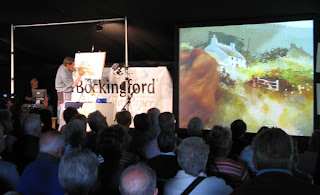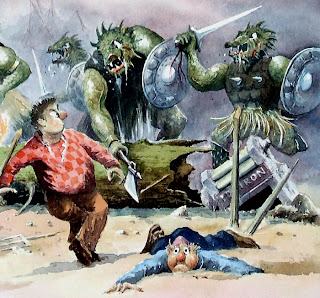Jenny and I demonstrated at the Patchings Art & Craft Festival in Nottinghamshire last week – the best annual show of its kind in Britain in a lovely rural setting with thousands of happy faces enjoying the art, crafts and the band. Jenny showed her pastel-painting techniques in the Search Press tent to enthusiastic audiences, while I did my usual watercolour demonstrations in the St Cuthberts Mill Celebrity Artist marquee, and also taking a couple of forays down to the Search Press tent in my tractor. My daughter Catherine gave us tremendous support, and, in fact, we would have been in trouble without her.
Patchings is superbly well organised. They place a massive screen on either side of me, on which the audience can see every mistake I make in enormous detail, as you can see on the right where my hand occupies one third of the screen. You can view the composition clearly, although only part is showing.
The image that you can see on the screen above illustrates clearly how leaving the paper white in places will have considerable impact on that part of the painting. Here the white cottage forms the centre of interest
which is supported by a gate that is mainly white. I often do this even if the building is not white. In this instance I used masking fluid to retain the white areas, although there are a number of ways of achieving this. It pays, therefore, to consider your whites before you touch the paper with the brush, because with watercolour it is almost impossible to get it back to a pristine white once it has been painted over.
The white paper – here I have used the superb Saunders Waterford High White in a rough surface – is an exceptionally powerful tool in your watercolour painting. Make the most of it!




